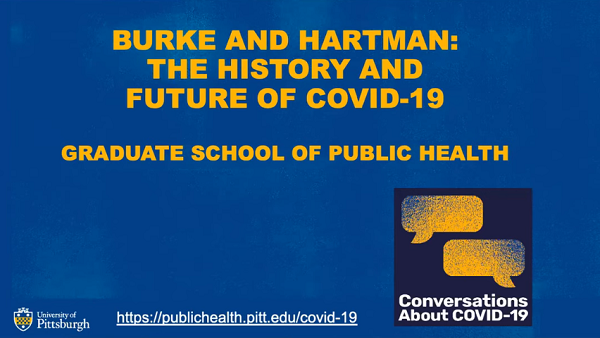
The History and Future of COVID-19 (May 8)
COVID-19 is one of three novel coronavirus outbreaks in the past 20 years that originated in animals. How is the current outbreak similar and different from the previous ones? What course will COVID-19 take in Pennsylvania? IDM's Amy Hartman puts the current outbreak in perspective with what we know (and don’t know) about SARS-CoV-2. EPI's Donald Burke discusses the epidemiological and environmental factors that will shape the likely phases of the COVID-19 epidemic in our region, and how we can prepare for them.
Watch on YouTube or click below
Additional Q and A from the 5/8 seminar
1. In SARS experimental literature, injecting previously exposed animals with antibodies to SARS spike exacerbates subsequent disease (antibody enhanced entrance?). Is this a confounding issue for immunity (natural or viral)?
Yes, the concerns about partial or incomplete immunity as potentially causing altered pathogenesis are real. Although there is a race for the vaccine, the breakneck speed will have to be tempered by careful attention to these potential negative consequences of misdirected immunity.
2. If this virus is seasonal, why does it spread in warm southern states and other countries in warm/hot climates such as the Caribbean, Australia, and countries in Africa?
The seasonal effect on transmissibility is not 100%. The virus can still be transmissible, especially in places where there is a completely non-immune population, or a high population density, or other factors favoring viral transmission. The seasonal effect gives a boost, but is not the only or absolute determinant of transmission.
3. What advice would you give to schools or those making decisions about whether or not schools will re-open in the fall?
The choice about school opening is a difficult one. We desperately need to know more about how much virus has been transmitted among children to make good decisions about the risk to the children themselves, and the risks that they may pose to their elders.
4. Should a fall/winter social distancing strategy be more of a localized plan vs. a one size fits all? What about he transmission by children?
The distancing strategy for different geographic and political jurisdictions should be tailored to the local specific circumstances. New York City is very different from rural southwest Pennsylvania counties, such as Greene County, Pennsylvania. The degree of social distancing from the norm will have to be considerably greater in places where there is a high population density. Regarding children, the need for better information is critical.
5. Do we understand exactly why coronavirus display seasonality?
No, we don’t understand coronavirus seasonality very well. For influenza, there is reasonable scientific evidence that it is the absolute humidity that may be important. This probably has something to do with the stability of the virus in airborne suspensions. Human seasonal behaviors, like school opening and closing play a role, but there is almost certainly a element of physical environment affecting the virus directly as well.
6. Can you clarify Dr. Mikovitz's views on t he type of virus and the origin of the virus from a lab in North Carolina?
I don’t want to give any credence to Dr. Mikovicz's views. While I do think it is a legitimate question about exactly how the virus emerged from bats into humans, the notion that it came from a lab in North Carolina is completely unsupported by facts.
7. Do we have a sense of the total excess mortality that directly results from reduced health care (either by patient choice or reduced capacity) and related factors?
It seems like that should have a bigger impact on public health strategies than it seems to be getting - it would seem that excess mortality will be far worse in strategies that depend on herd immunity than “just the deaths” that can be attributed directly to COVID-19.
Yes, reduced attention to health activities of all kinds, both healthcare and preventive health - in the form of vaccines and other preventative methods - are some of the serious negative consequences of social distancing. Other consequences include not only education of children, but socialization of children, mental health.... the list goes on. Getting the balance right means taking into consideration all of these factors.
8. What do you anticipate the consequence will be of several governors' decision to reopen states?
The Pennsylvania’s governor‘s decision has been sensible and measured. For social distancing to continue to open up, we will need to ramp up our testing and contact tracing substantially.
9. How do public health efforts balance with the economic and mental health costs?
The answer to this is similar to my answer to number seven. I would add, that merely listing the negative consequences of social distancing is not sufficient. We need to be able to measure these consequences, and quantitate these negative effects, and track them in order to have a shot at mitigating these effects, and arriving at a proper balance.
CONVERSATIONS ABOUT COVID-19 | PITT PUBLIC HEALTH SEMINAR SERIES
Each Friday this May and June, Pitt Public Health experts will have a conversation about different aspects of the COVID-19 pandemic and then address questions from the seminar attendees. The goal of the COVID-19 seminar series is to provide our school community, alumni, and the public with credible information about the virus and the associated health impacts.
5/12/2020